Some anglers yearn for a delicate trout; slowly rising from the depths of a deep, dark pool to inhale the smallest fly. Yet others love trout like teenagers at a diner with a burger – fast and furious. For these latter trout hunters fast water provides the hottest action.
As a general rule trout love cool, well-oxygenated water, and this mostly occurs in mountain areas. Although the streams themselves may not be situated up in the hills, they nevertheless will be found in proximity. And more often than not it means fast flowing waters!
Dealing with fast water can be daunting for the uninitiated but follow a couple of simple rules and you’ll find quick streams both a delight and productive area to target trout.
Locating trout in fast water is relatively easy. Unlike fish in slower pools, which tend to cruise the area, fast stream trout tend to hold in one or two locations. The key to locating such areas is looking for a combination of protection from the current and access to food items.
On the subject of current protection, fish undoubtedly seek out shelter in two ways. Firstly, they hug the bottom. Due to ‘drag’ on the flow from the streambed you’ll find slower current near the bottom. Secondly, fish will choose positions where the energy of the current is dissipated by structure. The most common is a mid-stream boulder. Whilst it is often assumed that fish shelter behind a boulder more often than not they will ‘ride’ the pressure wave in front of the obstruction. Here they have a greater chance of detecting food items flowing with the current and can adjust their position to intercept it quicker.
A simple experiment is to drop a handful of leaves into a stream and watch their drift patterns. Where a sizeable rock obstructs the current the leaves will stop and spin in front of the boulder for a brief period before being swept passed. If casting with flies, then make sure you are well upstream of such locations. Lure presentation depends upon allowing the imitation to swing down and across the nose of the obstruction with the current.
Where obstructions such as rocks are not present, look for drowned tree trunks across the stream. Again these form areas where stream flow is retarded and fish expend less energy holding stationary. Fence crossings and associated ‘flood gates’ also warrant a few casts.
Access to food items in fast water dictates that fish expend less energy to procure the food items than the item provides. For example, a fish will not swim through a metre of fast current to intercept a single nymph; it would obtain less energy from the nymph than it expended catching it.
Fish will therefore station themselves as close to the food ‘lanes’ as possible. By nature the majority of fast water food is invertebrates that, for whatever reason, are drifting with the current.
Trout take advantage of the bait being funnelled by the current into the main flow. Look for the bubble line, which generally highlights the position of the main current. Seek out areas where this passes close to mid-stream structure, undercuts banks or overhanging bush, and target them.
The second rule about targeting trout in quicker streams is accurate casting. Fast water trout are adept at quickly snatching any fast drifting prey item and will generally not move far to procure it.
When casting in lakes or slower rivers we tend to target a lot of water depending upon the conditions. Yet in fast streams this would largely prove fruitless. You need to locate where the fish are holding and accurately target the area.
A cast made further than 30cm from a fish will probably not elicit a response. It is imperative when targeting these waters that you put your offering close to the fish.
The difference between rejection and a take is often dictated by the vertical positioning of the lure/fly. A fly passing 30cm above a fish may also not draw a result. Hence, the key is to either fish right on the bottom or right on the top water.
Bottom angling calls for weighted lures and flies. Feather tossers will also need to increase their leader length to about a third longer than the water depth. The easiest way to get flies down is by adding a split shot to the leader.
The preferred method when tying on the tippet is to leave a tag end and clip your weight to it. This way, should you foul the bottom the weight should slide off the tag and you’ll not lose the fly or leader.
Vital to the success of the technique is to drift your imitation into the strike zone. Don’t cast directly into the zone, as the fly will have passed before the fish is even aware of it. Cast well above the zone and allow your offering to be carried by the current into the hot spot.
Strikes will be extremely quick and the inattentive angler will miss plenty of fish. Fast water trout have milliseconds to sum up an approaching item, decide whether to hit it and then strike. For this reason, when targeting fast water fish I tend to upsize my leader to handle the more rugged responses.
It is a common mistake made by many anglers. When fishing a stream they tend to focus on the direction they are travelling, either up- or downstream. As a general rule I try to fish upstream, especially when fishing flies. It allows my wets to sink better and offers more drag-free drifts for my dries.
Under some circumstances it may be suitable to drift a fly downstream to get it under tight cover. The problem is you’ll need some slack in the system and that usually results in missed strikes.
Lure anglers will, however, often do better casting either downstream or across the current. When casting upstream it is very difficult to retrieve line onto the reel fast enough to keep in contact with the lure. The result is usually insufficient hooking power. You need to get rid of slack line.
Casting across current or downstream allows lure flickers to maintain contact and eliminate slack ensuring that takes result in a positive connection. Retrieving against the current also ensures a little action is imparted into the lure as quickly as possible.
Lure or fly selection is not so critical in fast water scenarios. If it looks like tucker and you get it within 30cm of the fish, chances are they’ll hammer it. More important than colour or perhaps even size is choosing an imitation that gets into the fish’s proximity.
All anglers need to match weight to the current speed. Floating divers have no place here; either jigheads or metal lures will prove the most effective. Because strike zones can be very small you need something that draws a fish’s interest quickly. For this reason, flash is a great addition to a lure. Often there just isn’t enough drift time for a lure to start developing action.
Fly anglers need to ensure their flies get down and dirty fast. The addition of rubber legs to both wet and dry patterns is a deadly stimulus. The fast, turbulent water instantly gets your pattern ‘struggling’ and fish can not resist the temptation. As a rule of thumb the faster the water then the larger the fly pattern.
Leave your English style dries at home. They generally don’t have the floatation necessary to fish all day on fast water, even when dressed with floatant. These days I rely more and more on foam patterned dries. Such designs will ride high all day ensuring your ability to watch the pattern and steer it into the right locations.
Targeting trout in big, fast water is not as difficult as you’d expect. Become competent at reading the currents and target those most likely to carry food passed sheltered lies. You’ll be bending the flick stick or long wand in no time!
Reads: 5712
The Khancoban tailrace – prime fast water trouting.
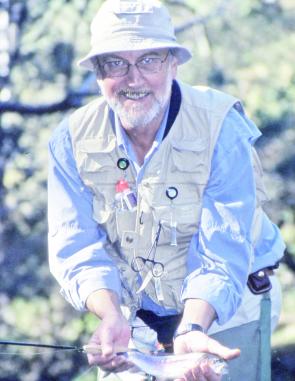
Alan McKie employed fast water tactics to success.

Upstream casting a fly to midstream boulders is a favoured technique with locals.

Bernie Barnsley works a Celta through a fast backwater.
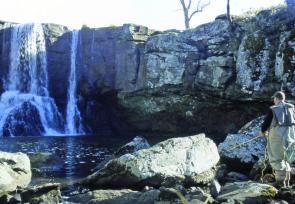
Waterfalls often occur along fast streams. Fish the plunge pools at their base.
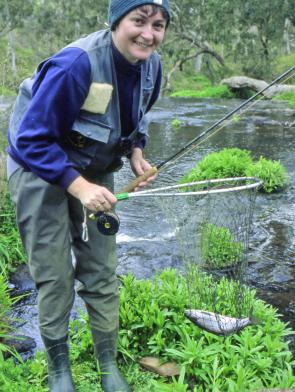
Meredith Duncan with a victim of a Bushy dry fly.

This solid brown fell to a deeply fished Wooly Bugger.
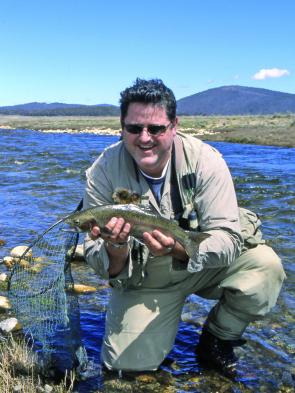
Daniel Raffaele with a fast water rainbow from the Eucumbene River.
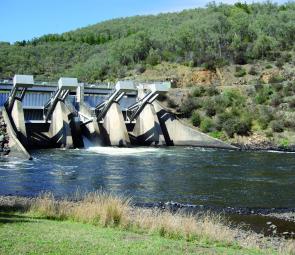
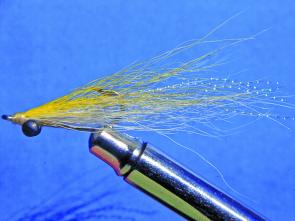
Although considered primarily a saltwater pattern, small clouser minnows are excellent fast water streamers.
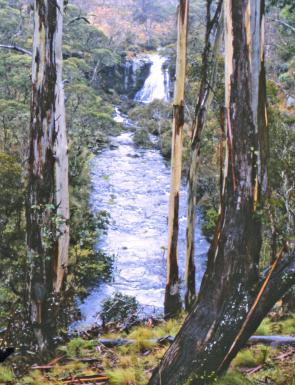
Magnificent rugged country and prime productive water.
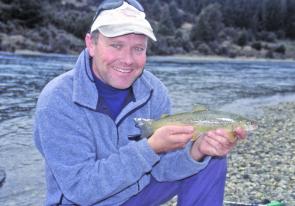
Fast water basics work anywhere, here the author holding a New Zealand brown.
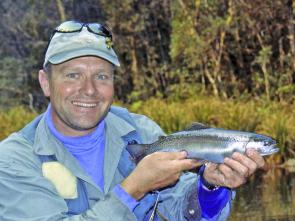
A good rainbow trout taken from a gorge pool.




